Research Article - (2025) Volume 3, Issue 1
Statistical Research of Rehabilitation Measures Persons with Disabilities.
Received Date: Dec 04, 2024 / Accepted Date: Dec 30, 2024 / Published Date: Jan 06, 2025
Copyright: ©2025 Andriy Semeniuk. This is an open-access article distributed under the terms of the Creative Commons Attribution License, which permits unrestricted use, distribution, and reproduction in any medium, provided the original author and source are credited.
Citation: Semeniuk, A. (2025). Monitoring the Position of Solar Panels Using IIS Algorithms. Eng OA, 3(1), 01-08.
Abstract
In recent years, a new concept of reforming the system of medical and social expertise has been implemented in Ukraine, which is associated with the use of the International Statistical Classification of Diseases (ICD-10) along with the International Classification of Work Ability, Disability, and Health (ICF). This allows for a comprehensive analysis of the patient's health and functioning, better planning of treatment, rehabilitation, and creation of services for people with chronic diseases or disabilities. However, for the successful and full use of these measures, it is necessary to have statistical developments on providing persons with disabilities with comprehensive rehabilitation and medical services, and to develop models of reforming the medical industry on their basis. This will allow for the effective implementation of these innovations in a short time, taking into account the characteristics of each region and types of diseases.
Keywords
Medical Statistics, Medical and Social Commission, Rehabilitation, Persons with Disabilities
Introduction
The development of computer technologies, their implementation in medicine and healthcare requires the analysis of morbidity, patient condition during rehabilitation, post-treatment condition, further determination of measures to reduce the risks of epidemics, disease outbreaks, the need for rehabilitation and treatment facilities, so modelling in medicine is becoming increasingly important, especially in today's conditions. Modelling methods can be used in various areas of medicine, especially in the areas of design, management and supply, where the main processes are effective decision-making based on the information received. The main purpose of these activities is to obtain, analyse, present and further use of data. During modelling, large amounts of data from various sources can be used for analysis, such as statistical databases of healthcare institutions, production facilities of specialized enterprises, scientific literature and test results of various methods and devices for treatment and rehabilitation.
Computer modelling of any processes is based on three basic concepts:
• Statistical information
• Rules
• The management structure
Statistical research is a key area of knowledge accounting and classification. Each state faced the need to solve practical state and economic problems. It is these needs that require the collection and processing of various types of information. Similar measures are also needed to increase the efficiency of the medical industry and its component - the rehabilitation system for people with disabilities. Problems in the rehabilitation system in Ukraine have been accumulating for years, but a significant increase in the contingent associated with hostilities requires their resolution in a short time. World experience and research results by Ukrainian specialists indicate that almost 100% of military personnel and the majority of the civilian population may need highly qualified assistance. Psychologists believe that in the case of insufficient treatment, post-war symptoms not only return over time, but also intensify. Soldiers who have experienced the horrors of war often suffer from insomnia, lack of emotions, irritability. In order for people to adapt normally to peaceful life, they must undergo treatment.
Ukraine, in accordance with the UN Convention on the Rights of Persons with Disabilities, consistently fulfils the state's obligations to such citizens to ensure their full life. To this end, the state has introduced a central database of persons with disabilities as a single system for collecting and summarizing statistical data. Its filling, establishing interaction between different links of the rehabilitation process at the local level and the sequence of different forms and stages of rehabilitation require the implementation of software tools at each level.
The developed expert system for processing and collecting medical data to assess the condition of patients and provide recommendations for their rehabilitation allows automating and digitizing this process.
Chapter 1
Statistics is one of the oldest branches of knowledge that arose on the basis of the need for accounting. It arose with the emergence of statehood in connection with the need to solve practical state and economic problems. This required the collection and processing of various types of information. In the process of managing the field of medical and social expertise and rehabilitation of persons with disabilities, ensuring its planned work, statistical methods make it possible to develop justified organizationally and methodologically correct solutions that combine the intuition of a specialist with a thorough analysis of the information received.
In order to have a general idea of the statistical methodology, it is necessary to consider the process of statistical research itself, which includes five main stages
1 - Determining the purpose and objectives of the study
2 - Collecting statistical material
3 - Preliminary data processing
4- Calculation and interpretation of generalizing indicators
5 - Modelling and forecasting
Among them, stages 2 and 3 are the most expensive in terms of human resources, and therefore require the implementation of computer processing tools.
The developed software tool allows for formalizing the description of the condition of a person with a disability, speeding up decisionmaking time. Information about patients is stored in an electronic database (Figure 1)
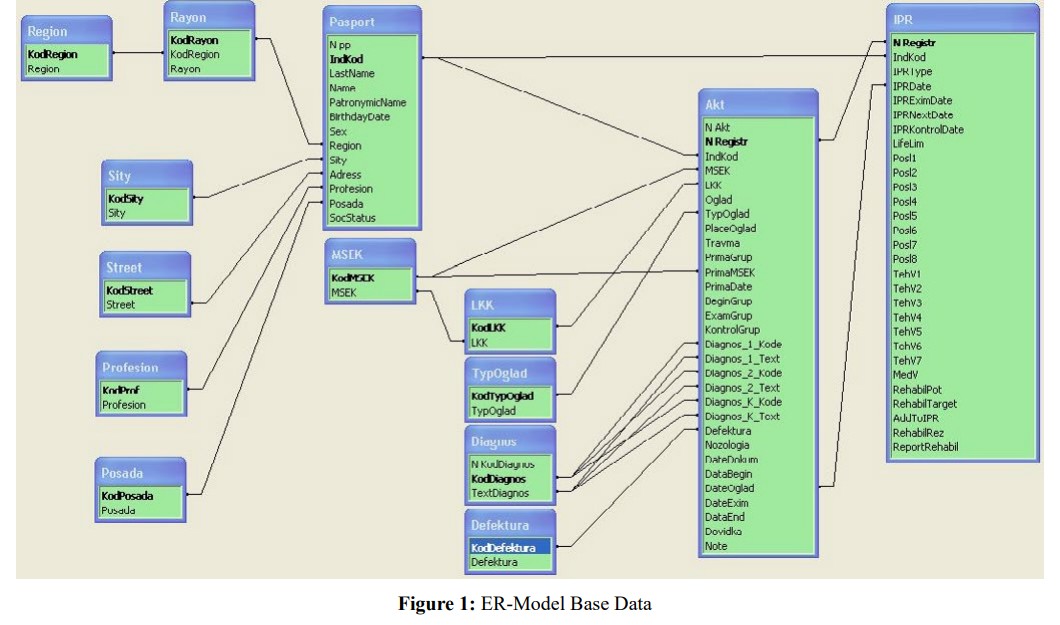
The program allows
• to collect statistical material
• to carry out preliminary data processing.
And then to carry out modelling of necessary rehabilitation measures based on the analysis and interpretation of statistical indicators.
Data maintenance takes place in interactive forms (Figure 2), after closing which the information is saved in the database in a new or edited record.
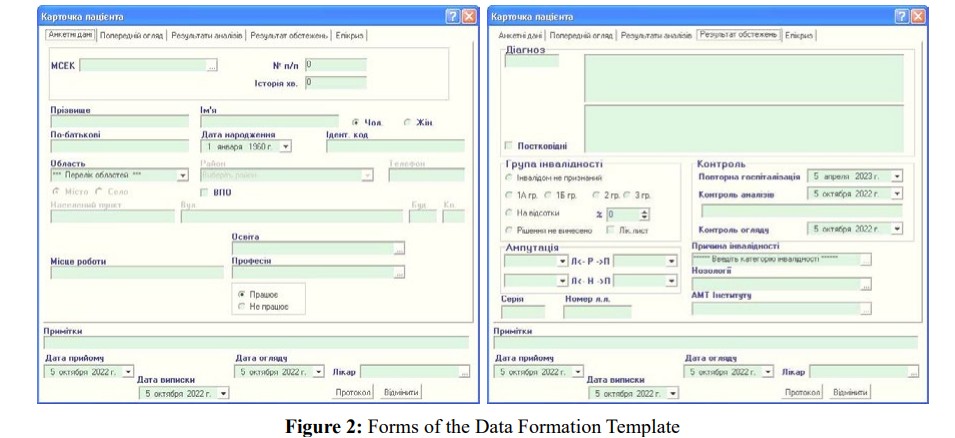
Data can be updated using menu commands, when opening a new or editing an existing record, or when the program is closed (Fig. 3). Data can be entered into the forms in any order. It is possible to supplement existing records.
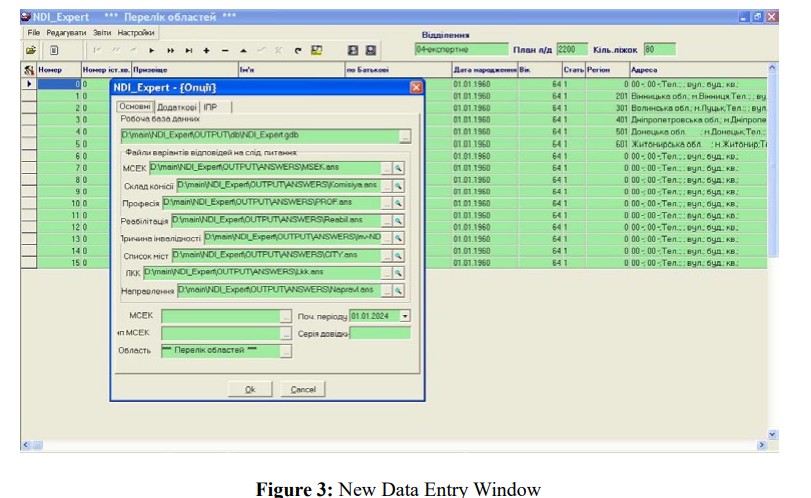
The accumulated data are analyzed using statistical research methods, taking into account the influence of factors on the issuance of recommendations regarding:
• Preventive measures
• Provision of psychiatric care
• Adaptation and creation of a workplace taking into account safety and special needs of a person with a disability
• Rational employment
• Physical and sports rehabilitation
• Teaching basic social skills
Using the obtained statistical data and their analysis in accordance with local characteristics allows not only to assess the results, but also to compare them with the results of work in other regions of Ukraine. In this case, functioning and limitations of vital activity are considered as a complex interaction of the individual’s health status with contextual environmental factors, as well as personal factors. Determining the state of vital activity requires an integrated assessment, which should be carried out from a systemic perspective and include a comprehensive analysis of the state of all interested functional systems of the body, the results of clinical and functional diagnostics, psychological characteristics of a person, professional and labor data and social factors of society. Only the comparison of various parameters of such a combined analysis allows to determine the presence and extent of limitations of a person's vital activity and ensures the quality of the expert examination.
Chapter 2
The problem of statistical analysis of medical data requires extraordinary solutions for its processing and interpretation of the results. In recent years, methods and means of data analysis have undergone fundamental changes, and the presentation of information in a convenient form has generally become an art. The data obtained as a result of the program's operation are combined into a number of tables. Statistical information is presented in the form of tables that are interconnected and undergoes the following stage of their processing and analysis:
• Establishment of potentially possible patterns and connections between individual components
• Availability of opportunities to predict new facts
The implementation of these requirements is impossible without presenting data in a computer format with their subsequent processing in digital form.
If qualitatively heterogeneous indicators become the subject of statistical study, then their analysis without prior grouping by qualitative characteristics does not correspond to objective reality. For example, not dividing people by age criteria, place of residence, working professions, etc., that is, into groups of social heterogeneity of health leads to distortion of conclusions.
Therefore, we perform a ranking of values. If they fall into the same gradation, then they are all assigned the same rank, which is calculated by the formula:
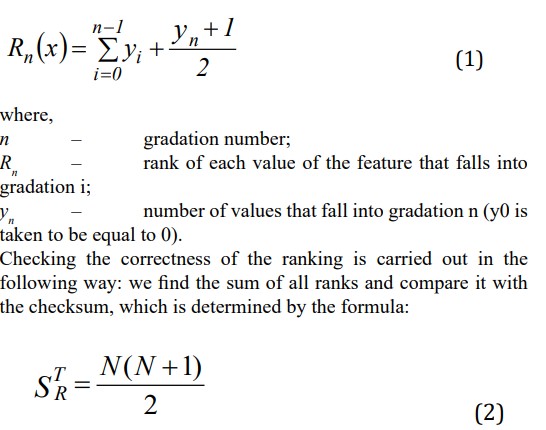
Thus, the ranking operation will allow us to move from qualitative features to quantitative features (Figure 4.).
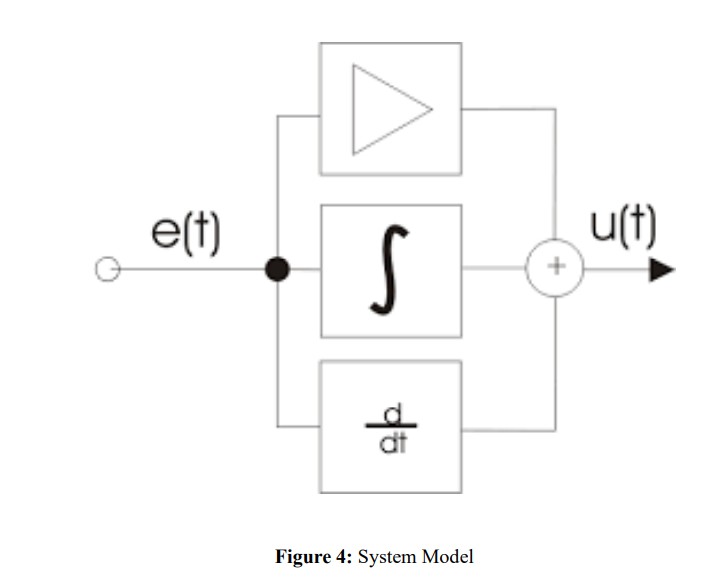
To assess the impact of data on the indicator under study, a univariate regression analysis is performed depending on each input value (variable) with the results displayed in separate windows (for example, Figure 5.).
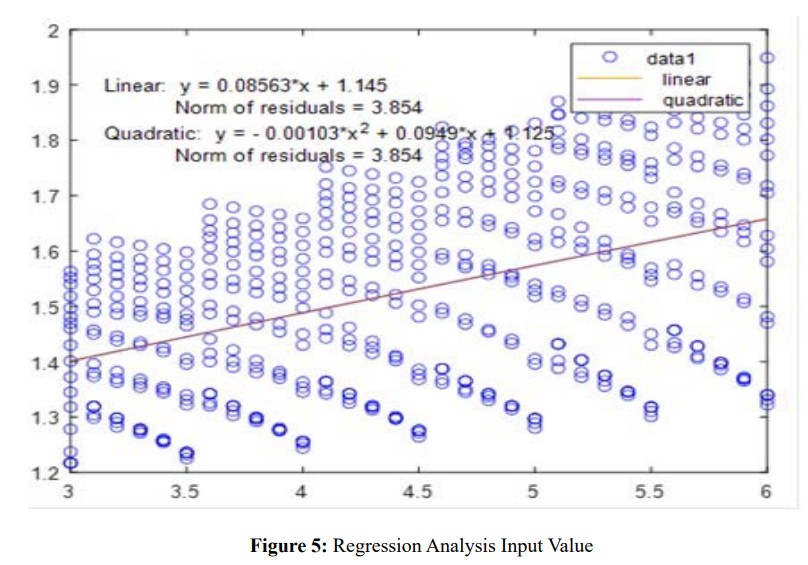
Regression analysis methods will make it possible to identify and investigate dependencies between various indicators, predict future trends, and perform complex calculations in the field of medical expertise (Figure 6.).
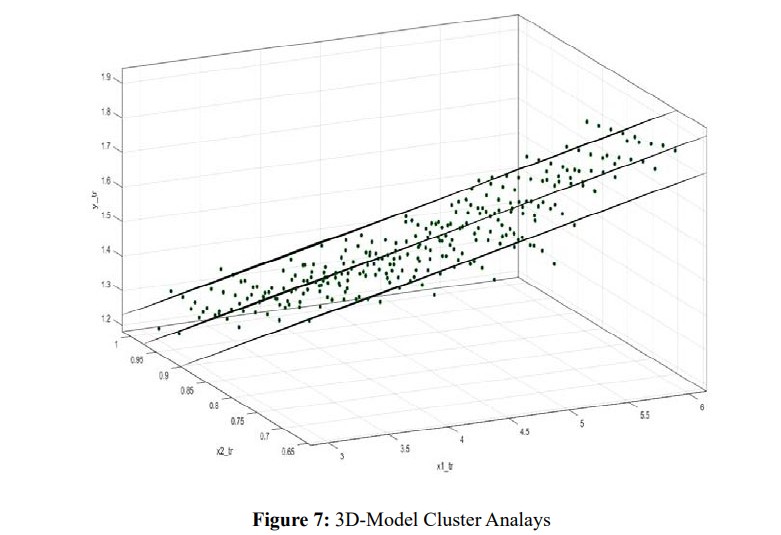
If an analysis is conducted by various accounting characteristics (age, gender, place of residence, profession, disease, etc), this will make it possible to study not only each element of the population, but also the entire population as a whole. But since most of the parameters are elements that fall under the concept of fuzzy logic, the processing is carried out using Takagi-Sugeno fuzzy control models.
In such models, between the set of input parameters
X = (x1 , x2 ,...xn )
and signals at the output of the system "Y" the dependence is given by a fuzzy knowledge base (fuzzy logic) of the form
p =1 i =1
â?» â?»(xi = ai, jp ) ® y = bj ,0 + bj ,1 × x1 + bj ,2 × x2 + ... + bj ,n × xn ; j = 1, m (4)
where,
bj, i – Coefficients ("significance") of the input parameters
Thus, in a Takagi-Sugeno type model, the knowledge base is a kind of hybrid model – in which the interaction rules contain references in the form of fuzzy sets and conclusions, and are represented, in the form of a linear function. Such a knowledge base (Figure 8) can be represented as some partition of the space of factors, which in turn have an effect on fuzzy subsets, in each of which the value of the response function to the input stimulus is calculated as a linear combination of inputs. Interaction rules are a kind of triggers for the transition between linear combinations of "input-output".
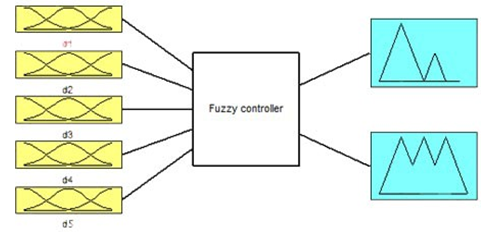
Figure 8: Takagi-Sugeno Type Model
Since the information is presented in the style of fuzzy logic, the boundaries of the subsets are fuzzy, and the subsets may partially fall into different combinations, but will have different coefficients. The visualization package allows you to output the result in the form of graphs of correlation of indicators and various histograms.
Conclusion
A large number of rules and indicators of difference are used in applied statistics. The question arises - how to reasonably choose one or another combination for use in a specific task. Data processing methods must be adequate in terms of permissible transformations of measurement scales of a set of fuzzy linguistic variables into a representative knowledge base.
The presented development allows for the collection and analysis of information, data from primary and diagnostic examinations on the health of the population; modeling and presentation of the result in graphical (Figure 9) and tabular (Figure10) form with the possibility of changing time limits and various environmental factors [1-7].

Figure 9: Graphical Representation of Statistical Reports
Using the package provides the opportunity to present both initial data for analysis and solve a variety of management tasks in the field of healthcare: from planning epidemic prevention measures, to optimizing the planning of the use of premises in a medical institution and the organization of the work of a medical institution and developing a strategy for launching new rehabilitation aids (RAs) on the market and their use.
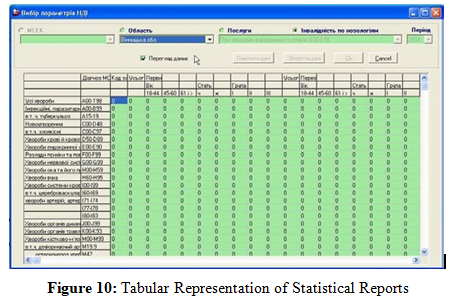
This package allows you to form the necessary management model in accordance with existing rules and facts.
During modeling, it is possible to analyze large volumes of patient data to identify patterns, correlations and relationships between various variables:
• Demographic information;
• Medical history;
• Treatment history.
This information will be useful when developing individual treatment plans. It can be used for:
• Developing new types and types of rehabilitation and auxiliary aids;
• Predicting which of them will be the most effective and least
toxic;
• Statistical modelling.
This, in turn, facilitates understanding of the specifics of the problem and promotes close cooperation between customers (healthcare institutions, people with disabilities), manufacturers, and social protection departments.
References
1. Shevchuk V.I., Perepelichna R.Ya., Belyaeva N.M., Storozhuk,L.O., Kurilenko I.V., Semenenko L.H., Semeniuk M.V., Semeniuk A.M. (2023). Main indicators of medical and social rehabilitation of persons with disabilities in Ukraine for 2022: Analytical information guide. Vinnytsia, FOP Danyliuk V.H.
2. Ipatov A.V., Moroz O.M., Khanyukova I.Ya., Hondulenko N.O., Sanina N.A., Ulyanova A.M. (2021). Main indicators of disability and the activities of medical and social expert commissions of Ukraine for 2020: Analytical information guide. Dnipro, Aktsent
3. Semeniuk Andriy. STATISTICAL RESEARCH OF REHABILITATION MEASURES (2023) Youth science for peace and development: collection of materials of the International scientific-practical conference (November 8-10, 2023, Chernivtsi). Chernivtsi: Chernivtsi National University named after Yu. Fedkovych, 2023. 430 p.
4. Semeniuk Andriy, Nikoliuk Petro MODELING OF DECISION-MAKING SYSTEMS OF MEDICAL EXPERTISE, Applied aspects of modern interdisciplinary research: materials of the II International Scientific and Practical Conference (Vinnytsia, November 24, 2023). Vinnytsia: DonNU named after Vasyl Stus. 2023. 282 p.
5. Shtovba S.D., Galushchak A.V. Identification of multifactorial dependencies using knowledge bases. Laboratory practical: electronic textbook. – Vinnytsia: Vinnytsia National Technical University, 2016. – 96 p.
6. Ruta, D. and B.Gabrys, “An Overview of Classifier Fusion Methods”, Computing and Information Systems (Ed. Prof. M. Crowe), University of Paisley, vol. 7, no. 1, pp. 1-10, 2000
7. Rotshtein, A. (2017). Design and tuning of fuzzy rule-based systems for medical diagnosis. In Fuzzy and neuro-fuzzy systems in medicine (pp. 243-290). CRC Press.



